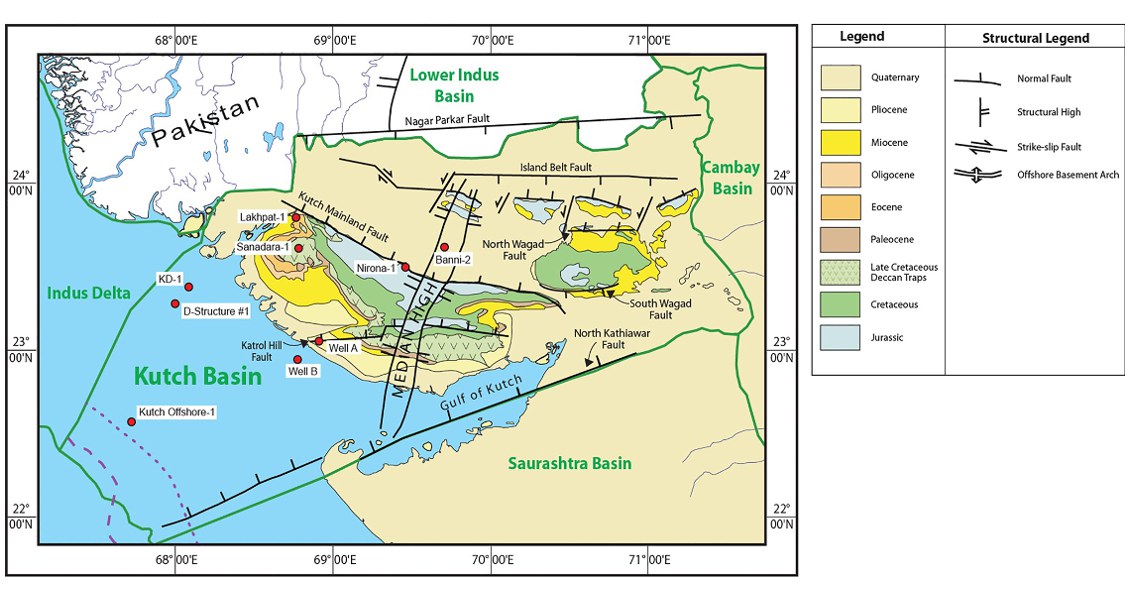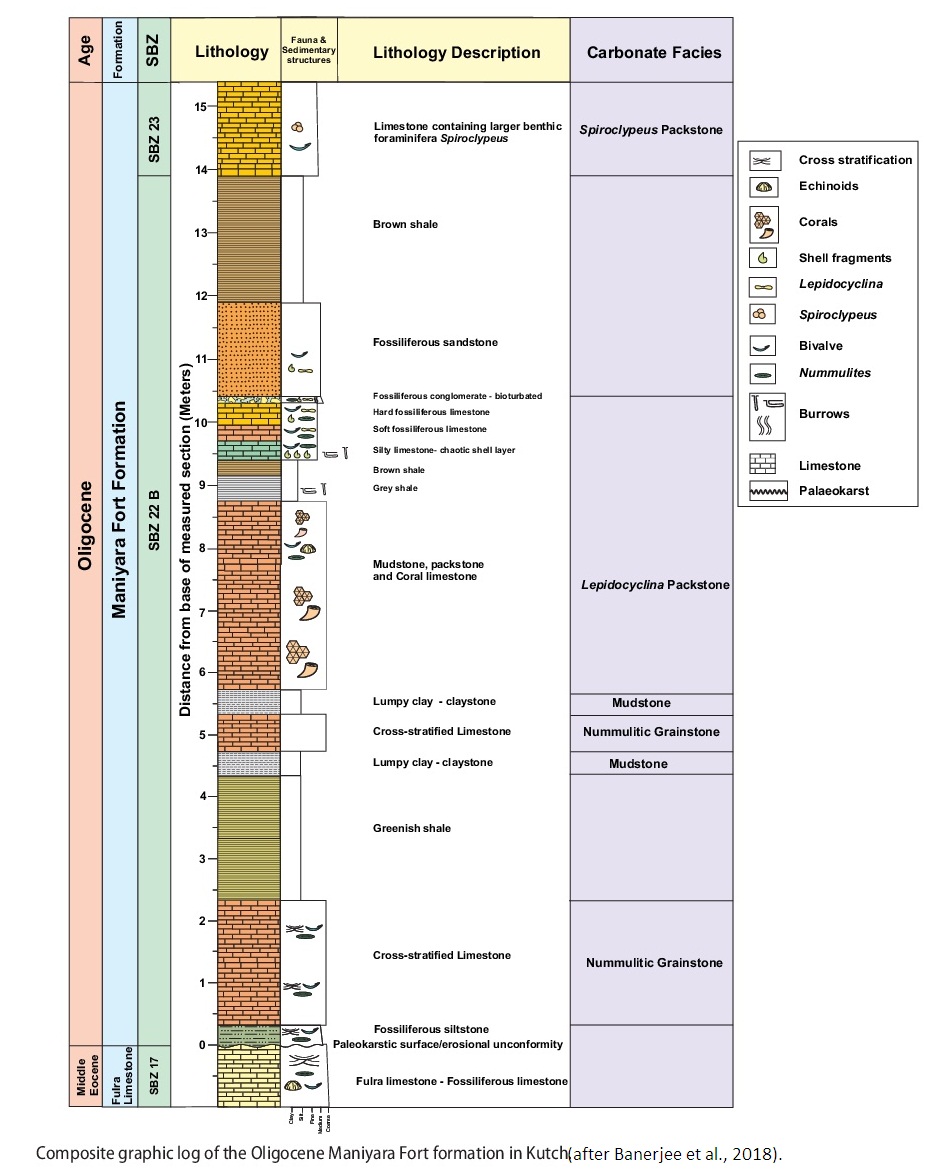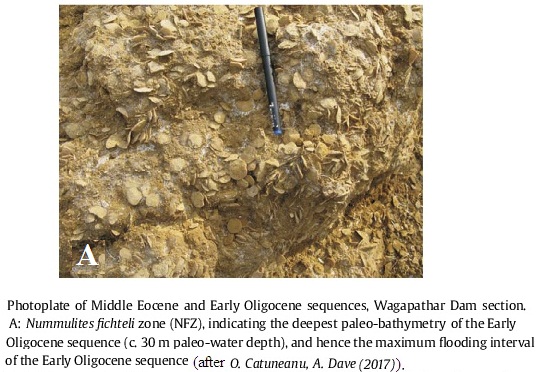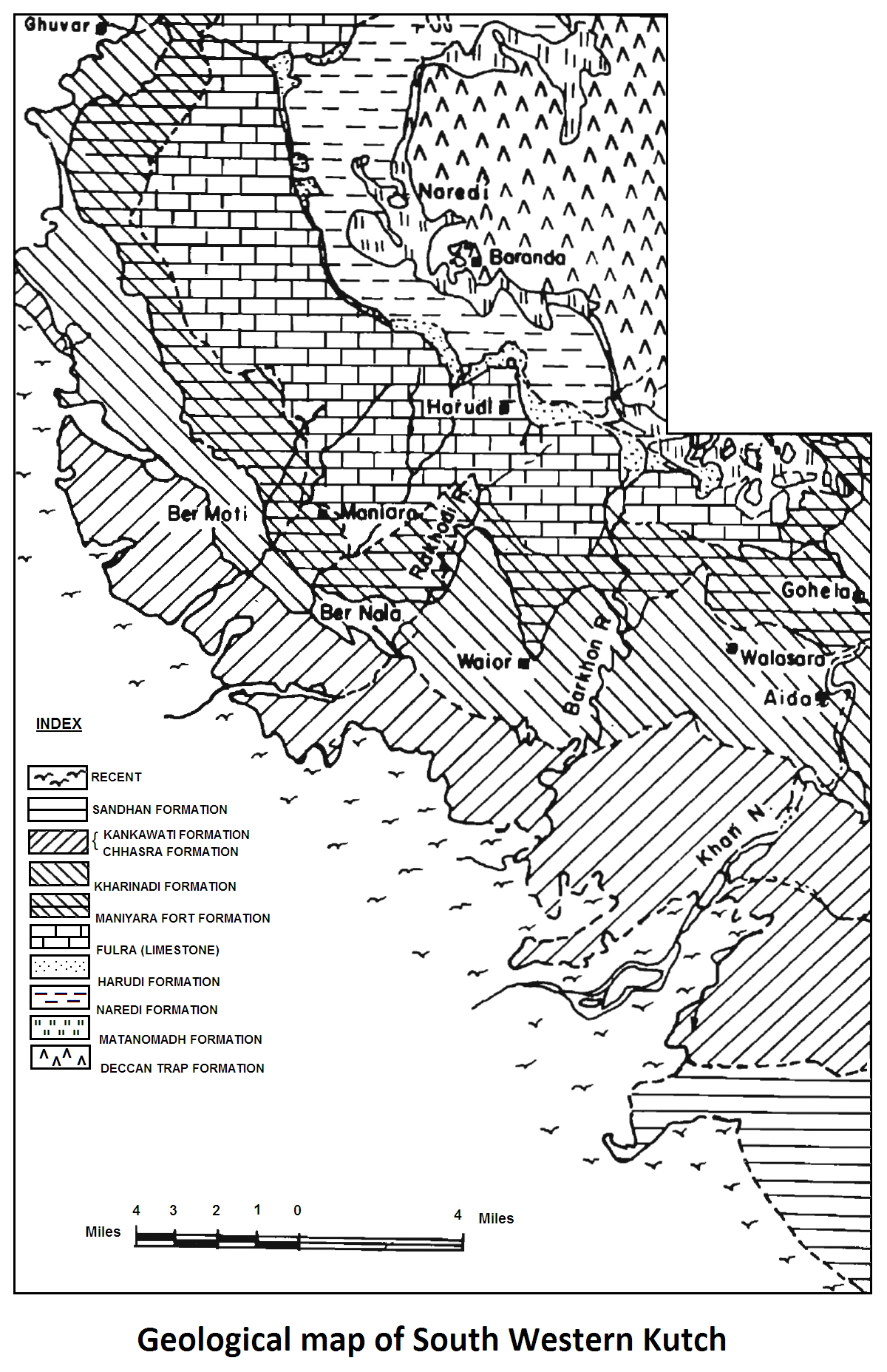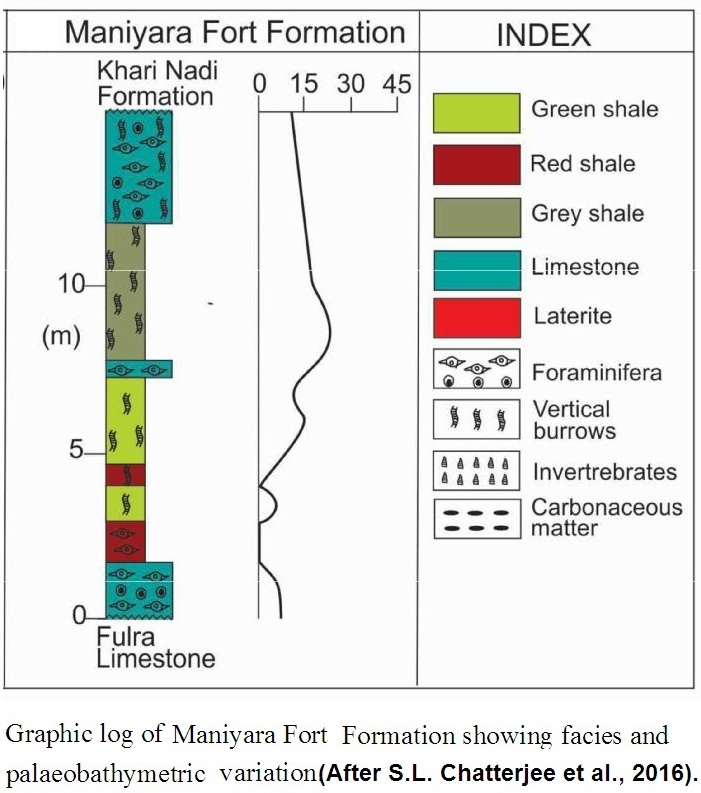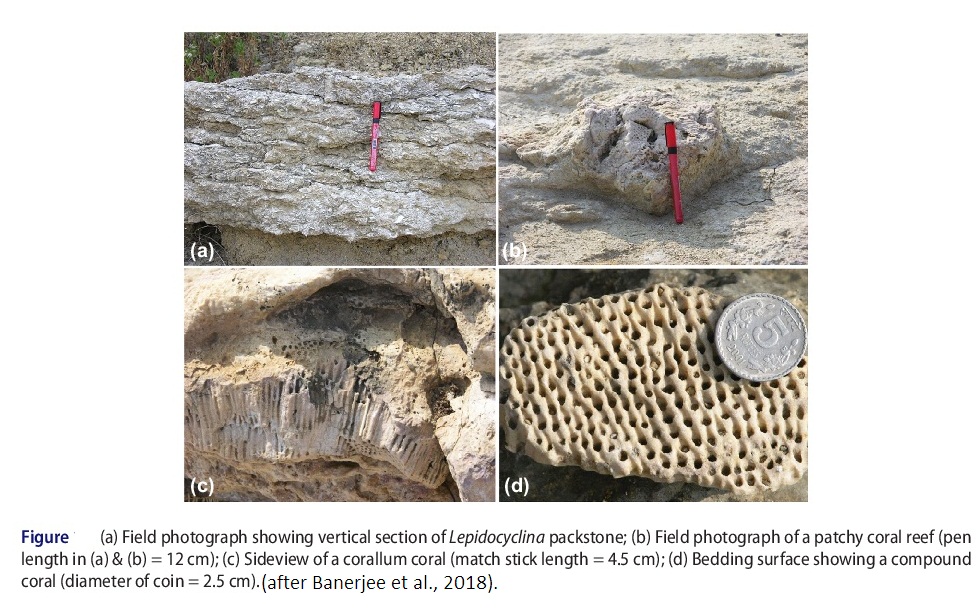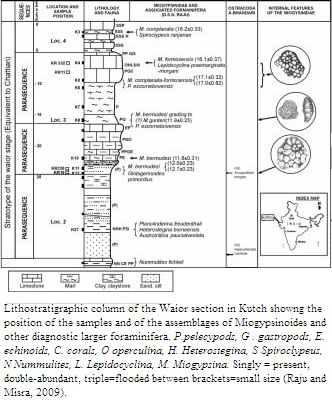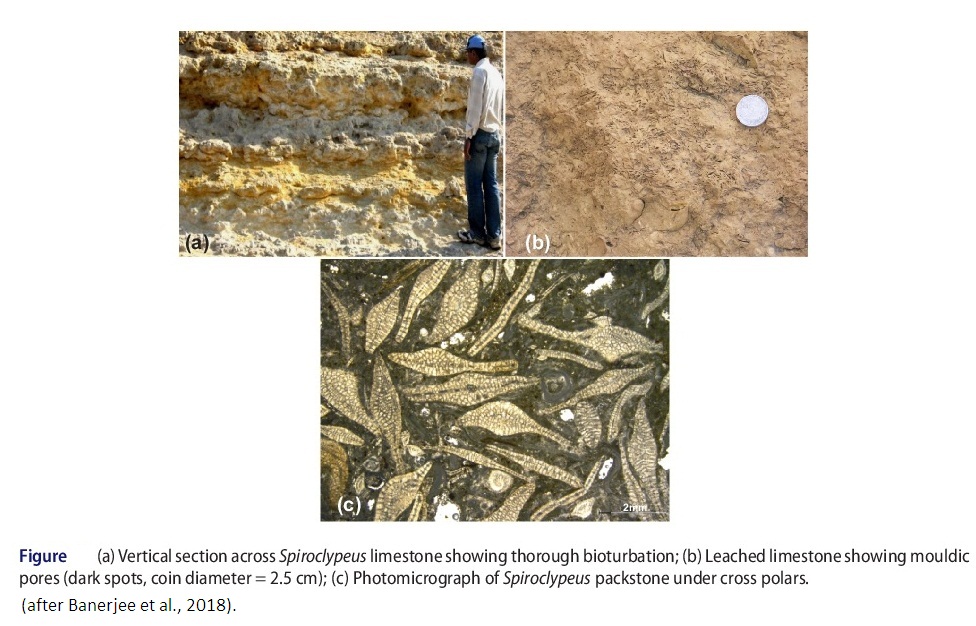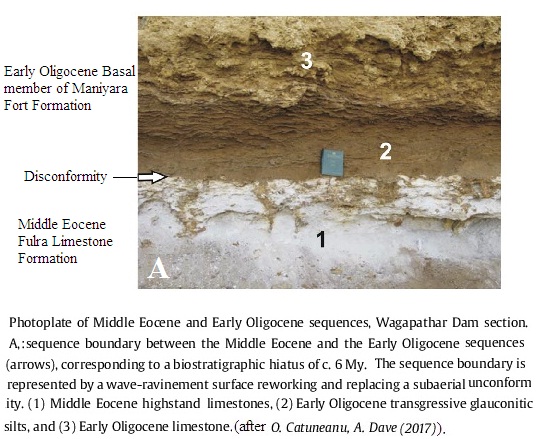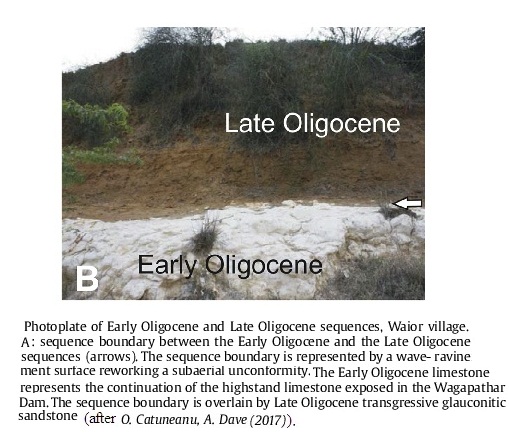Maniyara Fort Fm
Type Locality and Naming
OUTCROP. Named after its designated type section Maniyara Fort. The type section of the Maniyara Fort Formation, most of which belongs to the Early Oligocene, except for the upper Bermoti Member, is located 1.6 km NNE of Bermoti village, along the Barmoti river flowing between the Maniyara Fort and the Bermoti village. [Original Publication: Biswas, S.K. and Raju, D.S.N. (1971) Note on the rock stratigraphic classification of the Tertiary sediments of Kutch Quart. Jour. Geol. Min. Met. Soc. India.]
Synonyms: The related names are: Nummulitic Group (Wynne, 1872); Nari Series (Nagappa, 1959; Chatterjee and Mathur, 1966). (Source: Pandey and Dave, 1998).
Lithology and Thickness
Clayey limestone. A group of bedded, yellow to ochre colored foraminiferal limestones with a basal green glauconitic siltstone.
[Figure 1: Composite graphic log of the Maniyara Fort Formation. (after Banerjee et al., 2018)]
[Figure 2: Basal member of Maniyara Fort Formation (after O. Catuneanu, A. Dave (2017)]
[Figure 3: Geological map of South Western Kutch (after Biswas and Raju, 1973)]]
[Figure 4: Graphic log of Maniyara Fort Formation showing facies and paleobathymetric variation (after S.L. Chatterjee et al., 2016)]
MEMBER(S) - Four members:
1. Basal Member is 4 m thick and consists of alternating beds of foraminiferal, glauconitic, brownish to yellowish siltstone and calcareous gypseous claystone, the glauconite gets locally concentrated in the cut and fills of the lower disconformable surface.
2. Lumpy Clay Member is about 5 m thick and consists of cement color to brownish calcareous lumpy claystone, occasionally containing thin limestone and marlite beds
3. Coral Limestone Member is about 10 m thick and consists of dirty white nodular limestone, alternating with calcareous claystone in the lower part. The upper part comprises grey to dirty white massive limestone with abundant coral which frequently forms bioherms. The limestone is glauconite, biomicritic and biosperitic.
[Figure 5: Field photograph showing vertical section of Lepidocyclina packstone (afterBanerjee et al., 2018)]
4. Bermoti Member is about 10 m thick and is best developed in the stream SE of Bermoti and also NNE of Waior. It is also well developed at the top of Maniyarfort Hill. The lower part is best exposed in Waior and consists of rusty brown, friable, glauconitic argillaceous sandstone with pseudo-oolites. The upper part is composed thinly bedded very hard grey to yellowish foraminiferal limestone with interbeds of silty marlite full of Spiroclypes
The Bermoti Member near Waior Village is also the holostratotype of the Waiorian stage. The succession of lithoclolumn, Miogypsina, associated foraminifera and ostrocoda are given in the figure.
[Figure 6: Lithostratigraphic column of the Waior section in Kutch (after Raju & Misra 2009)]
[Figure 7: Vertical section across Spiroclypeus Limestone showing through bioturbation (after Banerjee et al., 2018)]
Relationships and Distribution
Lower contact
Lower boundary to the Fulra Limestone Fm is disconformable. Presence of Ochre and sudden appearance of glauconitic pellets make it easy to recognize in the field.
[Figure 8: Lower boundary of Maniyara Fort Formation (after O. Catuneanu, A. Dave (2017)]
Upper contact
In the on-land Kachchh, the upper boundary of the Late Oligocene Bermoti Member is by an unconformity marked by a persistent blue clay at the base of overlying Khari Nadi Fm of Early Miocene age.
[Figure 9: Upper boundary of Maniyara Fort Formation (after O. Catuneanu, A. Dave (2017)]
Regional extent
In Kachchh onland, the Early Oligocene outcrops are also exposed as a continuous belt south of Lakhpat. The sequence is also exposed in the Berwali river and the area around Lakhpat.
GeoJSON
Fossils
Five zones / biochrons are recognized within this formation. In the lower part biochron RAM-1 defined as an interval from FAD of Nummulites fichteli to FAD of Lepidocyclina isolepidinoides is recognized. Recognized nannoplankton assemblage referable to zone NN23 was recorded from this zone.
RAM-11, defined as an interval from FAD of L. isolepidinoides and LAD of N. fitcheli, is recognized in the Coral Limestone Member. Nummulites Clypeus is common in this zone.
Three zones/biochrons namely WA-I is defined from LAD of N.fichtlei to FAD of Miogypsinidae; WA-II defined as an interval from FAD of M. bermudezi to FAD of M. (M.) complanata; and WA-III defined as an interval from FAD of M. (Miogypsinoides) complanata to a level within a range of M. (M) gunteri. Two subzones/subchrons were recognized in WA-II and WA-III.
Age
Depositional setting
Seven to eight cycles/parasequences are recognized in the outcrops.
Raju (2009) recognized 7 third order stratigraphic cycles/ parasequences (4 in Ramanian Stage and ¾ in the Waiorian Stage). They are close to European data.
Additional Information
Sequence Stratigraphy -- Third-order sequence (Early Oligocene)
The overlying third order sequence, corresponding to the chronospan of the Late Oligocene, has been recorded in the subsurface and outcrops in several sections in the mainland. The lower boundary of the sequence is the Early/Late Oligocene unconformity (CIII 30), and the upper boundary is marked by the Late Oligocene/Early Miocene unconformity (C III 40). In the onland Kachchh, the Late Oligocene Bermoti Member, representing the upper part of the Maniyara Fort Formation, is separated from the overlying Khari Nadi Fm of Early Miocene age by an unconformity. The sequence consists dominantly of limestone with thin shales in the lower part, followed by sandstone, shale, and clay/claystone in the upper part.
In the present work, the sequence has been studied in the Waior section. Here, the lower part of the Late Oligocene is represented by transgressive glauconitic sandstone. The sequence continues downstream in an escarpment near the Waior village. This succession has yielded a rich assemblage of Miogypsina, enabling a high-resolution biostratigraphic zonation.
Chronospan: The lower third order sequence, between the Eocene-top unconformity (C II 40) and the Early/Late Oligocene unconformity (C III 30), corresponds to the chronospan of the Early Oligocene.
LB: The lower boundary of the sequence (C II 40) is a well-defined hiatus, as discussed above. The upper boundary (C III 30) is a feeble erosional unconformity of short time span, as demarcated by the absence of some species of Late Oligocene-Early Miocene Miogypsinoides-Miogypsina lineage (Raju, 1974). In other parts of the western continental margin (e.g., Mumbai offshore), the continuous Miogypsinoides-Miogypsina lineage across the Early/Late Oligocene suggests a conformable succession. The sequence corresponds to the lower three members of the Maniyara Fort Formation (i.e., Basal Member, Lumpy Clay Member, and Coral Limestone Member).
UB: The upper boundary of the sequence coincides with the lithostratigraphic limit between the Coral Limestone Member and the overlying Bermoti Member.
Geological distribution of Sequence: The sequence is recorded both in outcrops and subcrops. At the Wagapathar Dam, the sequence begins with Early Oligocene transgressive glauconitic silts over the Middle Eocene highstand limestone, with a pronounced hiatus of c. 6
The Nummulites fichteli zone (NFZ) indicates the deepest paleobathymetry of the Early Oligocene sequence (c. 30 m paleo-water depth), and hence the maximum flooding interval of the sequence. This maximum flooding interval subdivides the Early Oligocene sequence into a transgressive systems tract below and a highstand systems tract above.
In Babia hill, the sequence boundary between the Middle Eocene and the Early Oligocene sequences is represented by a wave-ravinement surface reworking a subaerial unconformity. Minor laterite detritus is occasionally observed as a transgressive lag.
In the Waior section, the Lower Oligocene limestone represents the Coral Limestone Member of the Maniyara Fort Formation, and the continuation of the highstand limestone exposed at the Wagapathar Dam. It is characterized by a rich fossil assemblage of gastropods, corals, bivalves, echinoids, and foraminifera. The sequence boundary with the overlying Upper Oligocene glauconitic sandstone (Bermoti Member).
